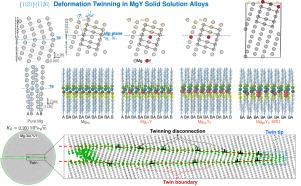Effects of Y solutes on the activation of the {112̄1}〈1̄1̄26〉 deformation twinning in MgY solid solution alloys
IF 9.3
1区 材料科学
Q1 MATERIALS SCIENCE, MULTIDISCIPLINARY
引用次数: 0
Abstract
The deformation twin is common in nominally pure HCP Ti, Zr, Re, Co, but not in Mg. Rare-earth (RE) solutes such as Y and Gd at low atomic concentrations, however, can activate this twin mode and make it competitive to the regular extension twin in Mg. Previously models have not explicitly revealed the role of RE solutes on twinning and the RE-effects remain poorly understood. Using a reduced-constraint (RC) slip path, DFT calculations and two newly-developed interatomic potentials for MgY and MgAl, we reveal the physical origin of the RE solute effects in activating the twin in MgY alloys with random and short range order solute states. The RC-path shows that localized slip in the twinning direction simultaneously drives shear and -direction shuffle displacements on the corrugated twinning plane. The shuffle displacements are essential to reverse the asymmetry of atom-planes to satisfy the twin symmetry. However, such shuffle displacements are insufficient in pure Mg or MgAl, leaving twin nucleation to the multi-layer slip path with high energy barriers. Y-solutes are able to enhance the slip-driven shuffling to levels sufficient to reverse the atom-planes asymmetry, leading to spontaneous nucleation of multi-layer twin embryo with reduced energy barriers lower than that for the competing extension twin in Mg. The RC-slip path and twin nucleation is directly demonstrated in atomistic simulations of a blunted cracks under mode-II loading. This slip driven, solute-modulated twin nucleation mechanism is expected to be general across all HCP metals and alloys.


Y溶质对MgY固溶体合金{112′1}< 1′1′26′>变形孪晶活化的影响
{112¯1}< 1¯1¯26 >变形孪晶在名义纯HCP Ti, Zr, Re, Co中很常见,但在Mg中不常见。然而,低原子浓度的稀土(RE)溶质(如Y和Gd)可以激活这种孪晶模式,并使其与Mg中的常规{101¯2}< 1¯011 >扩展孪晶竞争。以前的模型没有明确揭示RE溶质在孪生中的作用,RE效应仍然知之甚少。利用简化约束(RC)滑移路径、DFT计算和两个新开发的MgY和MgAl原子间相互作用势,揭示了具有随机和短程阶溶质态的MgY合金中激活{112¯1}< 1¯1¯26 >孪晶的RE溶质效应的物理起源。RC-path表明,< 1¯1¯26 >孪晶方向的局部滑移同时驱动了波纹{112¯1}孪晶面上的剪切和< 11¯00 >方向的shuffle位移。洗牌位移是扭转{11¯00}原子面不对称以满足双对称所必需的。然而,在纯Mg或MgAl中,这种洗牌位移是不够的,使得双核形成于具有高能垒的多层滑移路径。y溶质能够将滑移驱动的洗牌提高到足以扭转{11¯00}原子面不对称的水平,导致多层孪晶的自发成核,其能垒降低,低于竞争性的{101¯2}< 1¯011 >扩展孪晶。rc -滑移路径和{112¯1}< 1¯1¯26 >孪核直接体现在ii型加载下钝化裂纹的原子模拟中。这种滑移驱动的溶质调制孪核机制预计适用于所有HCP金属和合金。
本文章由计算机程序翻译,如有差异,请以英文原文为准。
求助全文
约1分钟内获得全文
求助全文
来源期刊

Acta Materialia
工程技术-材料科学:综合
CiteScore
16.10
自引率
8.50%
发文量
801
审稿时长
53 days
期刊介绍:
Acta Materialia serves as a platform for publishing full-length, original papers and commissioned overviews that contribute to a profound understanding of the correlation between the processing, structure, and properties of inorganic materials. The journal seeks papers with high impact potential or those that significantly propel the field forward. The scope includes the atomic and molecular arrangements, chemical and electronic structures, and microstructure of materials, focusing on their mechanical or functional behavior across all length scales, including nanostructures.
 求助内容:
求助内容: 应助结果提醒方式:
应助结果提醒方式:


